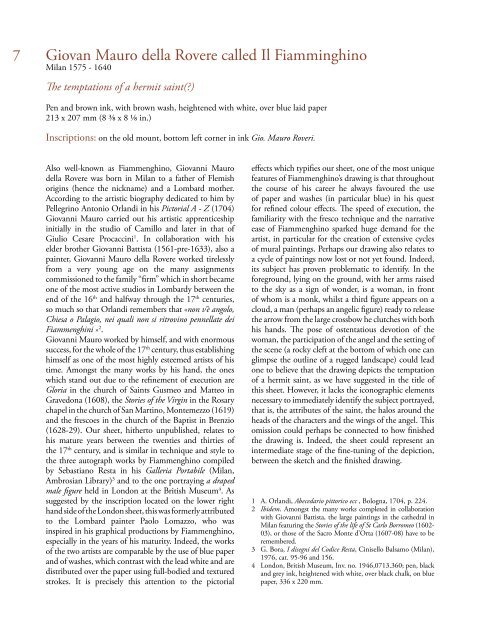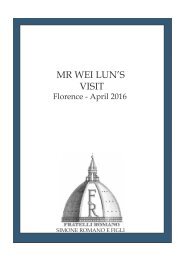A selection of master drawings 2016
- No tags were found...
Create successful ePaper yourself
Turn your PDF publications into a flip-book with our unique Google optimized e-Paper software.
7<br />
Giovan Mauro della Rovere called Il Fiamminghino<br />
Milan 1575 - 1640<br />
The temptations <strong>of</strong> a hermit saint(?)<br />
Pen and brown ink, with brown wash, heightened with white, over blue laid paper<br />
213 x 207 mm (8 ⅜ x 8 ⅛ in.)<br />
Inscriptions: on the old mount, bottom left corner in ink Gio. Mauro Roveri.<br />
Also well-known as Fiammenghino, Giovanni Mauro<br />
della Rovere was born in Milan to a father <strong>of</strong> Flemish<br />
origins (hence the nickname) and a Lombard mother.<br />
According to the artistic biography dedicated to him by<br />
Pellegrino Antonio Orlandi in his Pictorial A - Z (1704)<br />
Giovanni Mauro carried out his artistic apprenticeship<br />
initially in the studio <strong>of</strong> Camillo and later in that <strong>of</strong><br />
Giulio Cesare Procaccini 1 . In collaboration with his<br />
elder brother Giovanni Battista (1561-pre-1633), also a<br />
painter, Giovanni Mauro della Rovere worked tirelessly<br />
from a very young age on the many assignments<br />
commissioned to the family “firm” which in short became<br />
one <strong>of</strong> the most active studios in Lombardy between the<br />
end <strong>of</strong> the 16 th and halfway through the 17 th centuries,<br />
so much so that Orlandi remembers that «non v’è angolo,<br />
Chiesa o Palagio, nei quali non si ritrovino pennellate dei<br />
Fiammenghini » 2 .<br />
Giovanni Mauro worked by himself, and with enormous<br />
success, for the whole <strong>of</strong> the 17 th century, thus establishing<br />
himself as one <strong>of</strong> the most highly esteemed artists <strong>of</strong> his<br />
time. Amongst the many works by his hand, the ones<br />
which stand out due to the refinement <strong>of</strong> execution are<br />
Gloria in the church <strong>of</strong> Saints Gusmeo and Matteo in<br />
Gravedona (1608), the Stories <strong>of</strong> the Virgin in the Rosary<br />
chapel in the church <strong>of</strong> San Martino, Montemezzo (1619)<br />
and the frescoes in the church <strong>of</strong> the Baptist in Brenzio<br />
(1628-29). Our sheet, hitherto unpublished, relates to<br />
his mature years between the twenties and thirties <strong>of</strong><br />
the 17 th century, and is similar in technique and style to<br />
the three autograph works by Fiammenghino compiled<br />
by Sebastiano Resta in his Galleria Portabile (Milan,<br />
Ambrosian Library) 3 and to the one portraying a draped<br />
male figure held in London at the British Museum 4 . As<br />
suggested by the inscription located on the lower right<br />
hand side <strong>of</strong> the London sheet, this was formerly attributed<br />
to the Lombard painter Paolo Lomazzo, who was<br />
inspired in his graphical productions by Fiammenghino,<br />
especially in the years <strong>of</strong> his maturity. Indeed, the works<br />
<strong>of</strong> the two artists are comparable by the use <strong>of</strong> blue paper<br />
and <strong>of</strong> washes, which contrast with the lead white and are<br />
distributed over the paper using full-bodied and textured<br />
strokes. It is precisely this attention to the pictorial<br />
effects which typifies our sheet, one <strong>of</strong> the most unique<br />
features <strong>of</strong> Fiammenghino’s drawing is that throughout<br />
the course <strong>of</strong> his career he always favoured the use<br />
<strong>of</strong> paper and washes (in particular blue) in his quest<br />
for refined colour effects. The speed <strong>of</strong> execution, the<br />
familiarity with the fresco technique and the narrative<br />
ease <strong>of</strong> Fiammenghino sparked huge demand for the<br />
artist, in particular for the creation <strong>of</strong> extensive cycles<br />
<strong>of</strong> mural paintings. Perhaps our drawing also relates to<br />
a cycle <strong>of</strong> paintings now lost or not yet found. Indeed,<br />
its subject has proven problematic to identify. In the<br />
foreground, lying on the ground, with her arms raised<br />
to the sky as a sign <strong>of</strong> wonder, is a woman, in front<br />
<strong>of</strong> whom is a monk, whilst a third figure appears on a<br />
cloud, a man (perhaps an angelic figure) ready to release<br />
the arrow from the large crossbow he clutches with both<br />
his hands. The pose <strong>of</strong> ostentatious devotion <strong>of</strong> the<br />
woman, the participation <strong>of</strong> the angel and the setting <strong>of</strong><br />
the scene (a rocky cleft at the bottom <strong>of</strong> which one can<br />
glimpse the outline <strong>of</strong> a rugged landscape) could lead<br />
one to believe that the drawing depicts the temptation<br />
<strong>of</strong> a hermit saint, as we have suggested in the title <strong>of</strong><br />
this sheet. However, it lacks the iconographic elements<br />
necessary to immediately identify the subject portrayed,<br />
that is, the attributes <strong>of</strong> the saint, the halos around the<br />
heads <strong>of</strong> the characters and the wings <strong>of</strong> the angel. This<br />
omission could perhaps be connected to how finished<br />
the drawing is. Indeed, the sheet could represent an<br />
intermediate stage <strong>of</strong> the fine-tuning <strong>of</strong> the depiction,<br />
between the sketch and the finished drawing.<br />
1 A. Orlandi, Abecedario pittorico ecc , Bologna, 1704, p. 224.<br />
2 Ibidem. Amongst the many works completed in collaboration<br />
with Giovanni Battista, the large paintings in the cathedral in<br />
Milan featuring the Stories <strong>of</strong> the life <strong>of</strong> St Carlo Borromeo (1602-<br />
03), or those <strong>of</strong> the Sacro Monte d’Orta (1607-08) have to be<br />
remembered.<br />
3 G. Bora, I disegni del Codice Resta, Cinisello Balsamo (Milan),<br />
1976, cat. 95-96 and 156.<br />
4 London, British Museum, Inv. no. 1946,0713.360; pen, black<br />
and grey ink, heightened with white, over black chalk, on blue<br />
paper, 336 x 220 mm.





